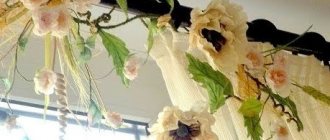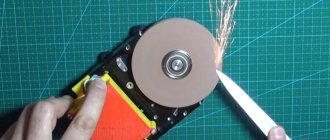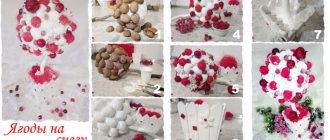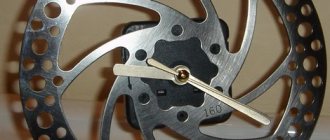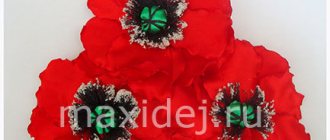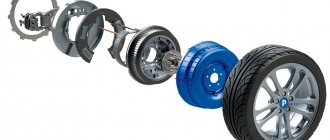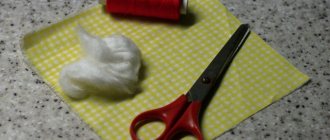Comfort in a home consists of little things. Even the most ideal design without accessories will look unfinished and the room will lack a lived-in feel. At the same time, the abundance of unnecessary trinkets only clutters the room. Therefore, in addition to beauty, the interior content should also be useful.
Such an accessory that combines aesthetics and functionality are special curtain holders. But before you run to the store or start making curtain tiebacks with your own hands, it would be useful to learn a little more about this beautiful and necessary little thing.
What are grabs for?
If you don’t want to open and then close the curtains every time, or you need to move the kitchen curtain away from the stove without exposing the window, or the room simply lacks individuality and bright accents - in all these cases, the best solution would be to use special holders.
With their help, you can adjust the level of illumination in the room without opening the curtains. This will also protect the fabric from becoming greasy and dirty. In addition, curtains collected and laid in beautiful folds look much more aesthetically pleasing.
A well-chosen accessory will not only save the curtains from wear and tear. It will favorably emphasize the design and texture of the material, and also hide possible shortcomings of the model.
Holders will help you visually adjust the proportions of the window. To do this, just play with the height of their location.
How to make a clamp yourself?
Making curtain tiebacks with your own hands is not at all difficult and will not incur extra costs from the family budget. You don’t need any special skills here, you just need to have the desire, the recommendations from the article will help you make this element without difficulty. Ribbons, ropes, beads, even old CDs, toys, cutlery will be used to help make a stylish grab.
Finding a photo of a curtain tieback will not be difficult; the Internet is replete with photographs of handmade crafts by folk craftsmen, allowing you to see the real appearance of a homemade tieback.
Initially, you need to decide on the design of the room; the furnishings of the room also matter when choosing materials for the manufacture of such a decorative element.
Using the tips from the article, you can easily and happily decorate curtains on a window or doorway.
Types of grabs
Among the variety of pickups, five types can be distinguished:
- fabric;
- hard;
- magnetic;
- cords with tassels;
- clips.
Let's look at each of them in more detail.
Fabric
They come complete with curtains, usually made from the same fabric as them. But this is in the most conservative version. Today's designers are making their wildest dreams come true with the help of textiles, bravely playing with the contrast of textures, patterns and colors.
For example, the delicacy and weightlessness of tulle curtains are favorably emphasized by clamps made of coarse burlap. And colorful curtains harmonize perfectly with plain holders.
Hard
Manufactured industrially. Most often - made of metal, less often - of plastic and wood. Attaches directly to the wall. They are convenient because you don’t need to tie, fasten or snap anything. All you need to do is hook the curtain onto the holder. The variety of forms is amazing: from a simple “doorknob” to real works of art.
Magnetic
An almost weightless, stylish accessory, which consists of a pair of magnets connected to each other with a textile tape, less often with plastic, and even less often with metal chains. It is convenient because it allows you to place the accessory at any height. It makes it easy to adjust the degree of grip of the curtains and form beautiful folds.
Cords with tassels
This is a classic among holders. Historians claim that similar ones were used in ancient Rome. In essence, it is just a cord, the ends of which are decorated with tassels. But it is the apparent simplicity that amazes with its sophistication and gives the interior a touch of luxury.
Hairpins
This holder consists of a base and a pin. As a rule, the base has the shape of an oval or round ring, but other geometric shapes are also found. Hairpins are decorated with rhinestones, beads, sequins, and patterns. The hairpin made using the kanzashi technique looks gentle and beautiful.
Purpose
The most suitable element for creative implementation is curtain tiebacks. In their manufacture, any fabrics and materials are used, the main thing is not to limit your imagination and find the right engineering solution. Pieces of fabric, beads, rhinestones, ribbons, threads and buttons will come in handy. You can make original tiebacks for curtains from disks, use “thematic” details for each room - you can’t count all the options.
But do not forget that in addition to aesthetic appeal, curtain tiebacks must perform direct functional duties:
- Tacks support the curtain fabric in assembled form: the strength of the fixing product is important, especially if the curtains are made of dense, heavy or multi-layered fabric.
- The width of the tie should be sufficient to form and secure a beautiful drapery of the curtain: a product that is too narrow will crumple the fabric, and a wide one will not hold carefully laid folds.
- Curtains assembled with a bright, interesting detail will fill the room with sunlight and become an eye-catching decorative element of the room.
Pickup attachment
The location of decorative elements plays a huge role. Not only the degree of illumination of the room, but also the harmony of the interior depends on it.
There are three possible options for mounting the holders:
- flush with the window sill (with vertical division in equal parts);
- below the window sill (the vertical is divided in a ratio of 2:1);
- above the window sill (ratio of top and bottom 1:2).
The values in brackets apply to panoramic windows or doorways.
Let's consider each option.
Placing the tiebacks at the same level as the window sill is the most common fastening method. The division of the vertical plane into two equal parts looks organic and does not hide the size of the windows. This position of the holders is good for children's rooms, bedrooms and living rooms.
Placing a decorative element slightly above the window sill divides the window opening into upper and lower parts in a ratio of 1:2. This method is great for kitchens and rooms with narrow windows, visually widening the opening and providing fairly good illumination. But there is one caveat: this option is absolutely not suitable for heavy curtains.
Fastening the holders below the level of the window sill harmonizes overly wide windows, visually narrowing them. Although this means that some of the natural light in the room is lost. This method is best suited for heavy drapes or multi-layered curtains.
Sharp kanzashi petals from two ribbons.
Kanzashi petals, I decided to make them in two colors. The first color is a combination of green and gold, and the second is a combination of yellow and gold.
Green and gold, kanzashi petal
Yellow with gold, kanzashi petal
I’ll show you how I made the green ones, and the yellow ones are done in the same way.
I took two satin ribbons: 2.5 cm wide and 7 cm long, each. I placed the green one on top of the golden one so that the golden one protruded along the top edge, 4 ml. Both tapes with the glossy (bright) side down. And then, as in the photo (I hope it will be clear).
- I singed both edges, pressed them with tweezers, thereby gluing both tapes together.
- Bend the right corner diagonally.
- Bend the left corner diagonally.
- The resulting triangle was folded in half.
- Exactly, cut off the lower part.
- I pressed the edges with tweezers, scorched them over the candle and pressed them again with tweezers so that the edges would stick together.
- I cut off the corner again.
- And again she scorched it over the candle, but now she did not press the edges so that the bottom would be through.
Spicy kanzashi petal
To decorate the tiebacks (both), I needed: green petals – 44 pcs., yellow petals – 42 pcs.
Also, for decoration, I made two yellow flowers from round, flat kanzashi petals. One for each pickup.
Clamps for other rooms
Depending on the purpose of the room, the following options can be distinguished:
- Clips for children's room. Cute naive tiebacks are created for curtains in a child’s room. You can buy them in stores or make them yourself. Curtain clips made from toys look funny. You can make an unusual clamp yourself using any standard clamp. Together with the child, he is decorated with toy figures and fabric cutouts. In craft stores they take beautiful butterflies and sew them onto tiebacks.
- Tiebacks for the bedroom. For light, neat curtains, clips with magnets are used. You can buy the base in a store or make it yourself from wide tape. It is folded in half lengthwise and the edges are sewn. Magnets are glued inside, a curtain is wrapped with a clamp and the edges are fastened. You can decorate magnets with halves of beads. You can also glue a magnet to the wall to secure the clamp in one position.
- Tiebacks for the living room. To decorate the living room, use all your imagination, because different styles are suitable for this room. This increases the choice of curtain tiebacks. Clips are made independently from laces, fabric, leather belts and even metal. They are decorated with beads, crafts made of fabric, and plastic. Fabric tiebacks are made in one color or with an ornament. Choose from both simple and complex hairpin designs. The main thing is that the clips are in harmony with the interior of the room.
On a note! On New Year's holidays, you can attach Christmas tree balls, tinsel, figurines of Santa Claus, Snowmen, and any other light holiday paraphernalia to the clips.
A little history
Kanzashi ("kanzashi" in Japanese) is a traditional hair decoration for Japanese women, which is a hairpin with unusual exotic flowers. This decoration has been popular since ancient times. Japanese women constantly tried to decorate their hairstyles and traditional kimonos in some special way.
Brooches and combs, handmade flowers, each distinguished by its beauty and uniqueness, were used. In the old days, these accessories could be worn according to the age and social status of the woman. Modern Japanese women are not controlled by any boundaries; they wear kanzashi according to their mood and preferences, but they always remember national traditions.
These hair accessories were made from a variety of materials: precious stones, tortoise shell, but silk products were especially valued. First, small squares were cut out of fabric, which were then rolled into petals using tweezers. Next, the petals were glued or sewn together and decorated in the core with beads, pearls, and gems. The result was a gorgeous textile flower.
What color to choose curtain holders
Universal options when choosing curtain holders are tiebacks made in black, chocolate or white. Gold-plated, chrome-plated, titanium and steel tiebacks will match any type of curtain.
Master class on making
Sewing curtain holders is not difficult, but the most exciting thing is decorating them. We offer you several options for manufacturing this part.
Model 1
Materials:
- 1 m of cord that matches the color of the curtains;
- beads;
- wire (d=2 mm) 3 m long.
Step-by-step instruction:
- Let's start with the pendants. First, we fix the largest bead on the wire, it will be the center of the composition: we string it in the middle and wrap the ends of the wire around it several times.
- Now we string the remaining beads a few centimeters on both sides. Alternate them as you like, the main thing is to maintain the same length of wire with beads on both sides.
- The next step is to attach the resulting pendant to the cord. We insert both ends of the wire through the cord (at a distance of half a centimeter from each other) and twist them. We cut off the excess wire.
- We continue to decorate the cord with pendants according to the described algorithm. The number, length, and intensity of pendants can be varied in any order.
- At the last stage of work, we tie the ends of the cord (you can decorate the hanging ends with beads) and fix the pendant on the mount - a hook driven into the wall.
Execution options in other decorative objects
Curtain holders are relevant in the bathroom. The curtain is laid in voluminous folds and secured with clips. In the bedroom, you can experiment with a canopy by choosing hook holders for it.
Curtain holders not only add sophistication to the interior, but are also practical to use. Using the clamps, you can regulate the flow of sunlight into the room; if necessary, increase or decrease the flow of fresh air from the street by opening the curtain near the heating system to improve the circulation of warm air.
There are a large number of options for in-house production or retail sale. You just need to decide on the right option.
